Crash of a Lockheed C-130E Hercules near Campo dos Afonsos AFB: 9 killed
Date & Time:
Sep 27, 2001 at 1215 LT
Registration:
2455
Survivors:
No
MSN:
4202
YOM:
1967
Crew on board:
9
Crew fatalities:
Pax on board:
0
Pax fatalities:
Other fatalities:
Total fatalities:
9
Circumstances:
While descending to Campo dos Afonsos AFB, the crew encountered poor weather conditions with limited visibility due to fog and rain falls. Too low, the four engine aircraft struck the slope of a mountain located about 15 km southeast of the airbase. All nine occupants were killed.

Crash of a Britten-Norman BN-2A-27 in Bujari
Date & Time:
Sep 22, 2001 at 1207 LT
Registration:
PT-KTQ
Survivors:
Yes
Schedule:
Rio Branco - Rio Branco
MSN:
493
YOM:
1976
Crew on board:
1
Crew fatalities:
Pax on board:
4
Pax fatalities:
Other fatalities:
Total fatalities:
0
Captain / Total hours on type:
300.00
Circumstances:
The twin engine aircraft departed Rio Branco with four passengers and one pilot on board. The goal of the flight was to carry four Japanese journalists who wanted to perform aerial views from various tribes located in the region of Santa Rosa do Purus. About 30 minutes into the flight, an oil leak occurred on the left engine that lost power. The pilot reduced his altitude and attempted an emergency landing when the aircraft crashed near Bujari, about 39 km from Rio Branco. The wreckage was found near motorway BR364 and all five occupants were slightly injured.
Probable cause:
The following findings were identified:
- It is likely that the pilot did not use the controls properly to maintain an adequate control of the airplane in a single-engine configuration while the airplane was operated within weight and balance limits,
- The left propeller retainer had been replaced by similar but not original equipment, using glue to ensure its tightness, which was non compliant with the engine manufacturer's procedures,
- The aircraft maintenance documents were not kept up to date by the operator,
- Poor flight preparation on the part of the pilot who did not notice that the maintenance documents were not up to date,
- The operator was not compliant with the current Brazilian Civil Aviation Authority legislation.
- It is likely that the pilot did not use the controls properly to maintain an adequate control of the airplane in a single-engine configuration while the airplane was operated within weight and balance limits,
- The left propeller retainer had been replaced by similar but not original equipment, using glue to ensure its tightness, which was non compliant with the engine manufacturer's procedures,
- The aircraft maintenance documents were not kept up to date by the operator,
- Poor flight preparation on the part of the pilot who did not notice that the maintenance documents were not up to date,
- The operator was not compliant with the current Brazilian Civil Aviation Authority legislation.
Final Report:
Crash of a Boeing 737-2C3 in Goiânia
Date & Time:
Sep 16, 2001 at 1053 LT
Registration:
PP-CJN
Survivors:
Yes
Schedule:
São Paulo – Goiânia
MSN:
21012
YOM:
1974
Flight number:
RG2240
Crew on board:
5
Crew fatalities:
Pax on board:
62
Pax fatalities:
Other fatalities:
Total fatalities:
0
Aircraft flight hours:
68500
Aircraft flight cycles:
65500
Circumstances:
On final approach to Goiânia-Santa Genoveva Airport, the crew encountered poor weather conditions with a limited visibility due to rain. The aircraft landed about 500 metres past the runway threshold but as it was misaligned, the right main gear touched down on the left side of the runway. The crew attempted to steer the plane back onto the runway when the right main gear collapsed. The aircraft went out of control, lost its right engine then its nose gear and came to rest on the runway. All 67 occupants evacuated safely.
Probable cause:
Wrong approach configuration on part of the crew who continued the approach while the aircraft was not properly aligned with the runway centerline.
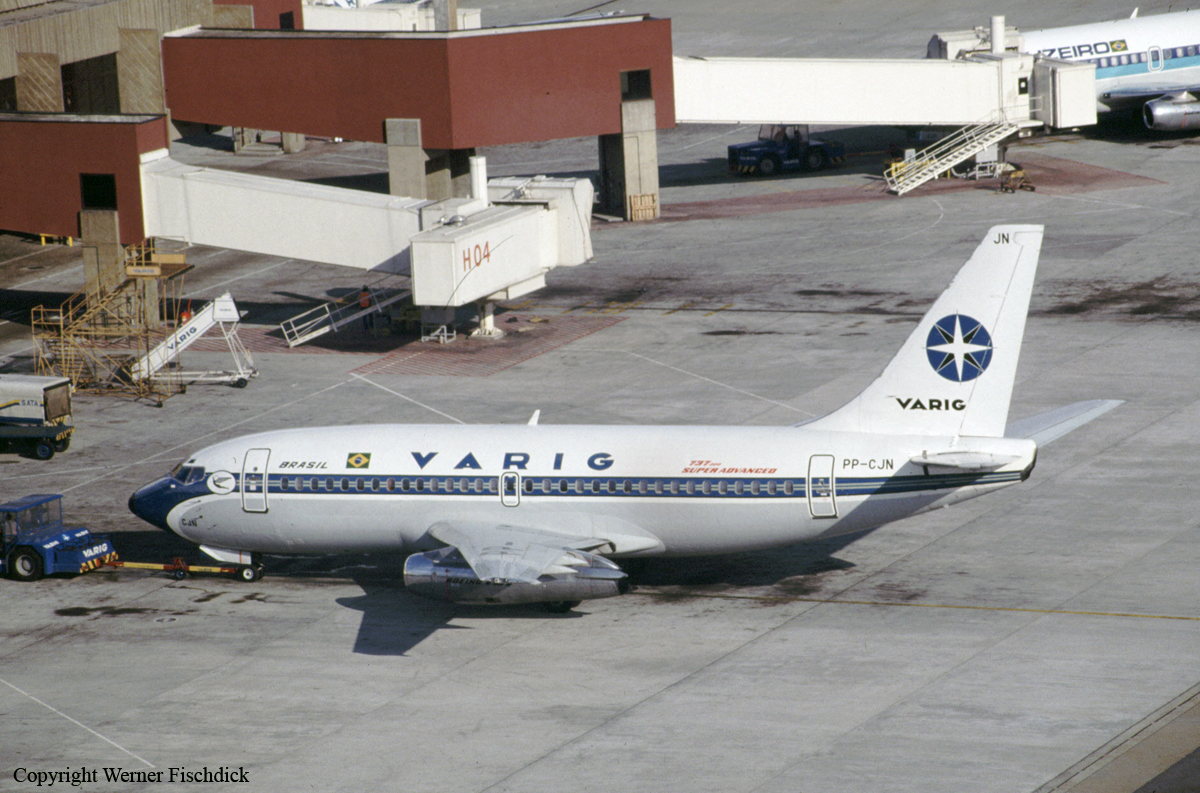

Crash of a PZL-Mielec AN-28 in Puerto Cabello: 13 killed
Date & Time:
Jul 12, 2001 at 1246 LT
Registration:
YV-117CP
Survivors:
No
Schedule:
Puerto Cabello - Caracas
MSN:
AJE001-10
YOM:
1996
Crew on board:
2
Crew fatalities:
Pax on board:
11
Pax fatalities:
Other fatalities:
Total fatalities:
13
Circumstances:
Operated by Overtec, the aircraft was leased from a Polish company and was engaged in a demonstration flight from Puerto Cabello to Caracas on behalf of the Venezuelan National Guard. Shortly after takeoff from Puerto Cabello-General Bartolomé Salom Airport, while climbing, the twin engine aircraft encountered difficulties to gain height, stalled and crashed in an open field, bursting into flames. The aircraft was totally destroyed by a post crash fire and all 13 occupants were killed.
Probable cause:
Loss of control during initial climb following a loss of power on one engine for undetermined reasons.
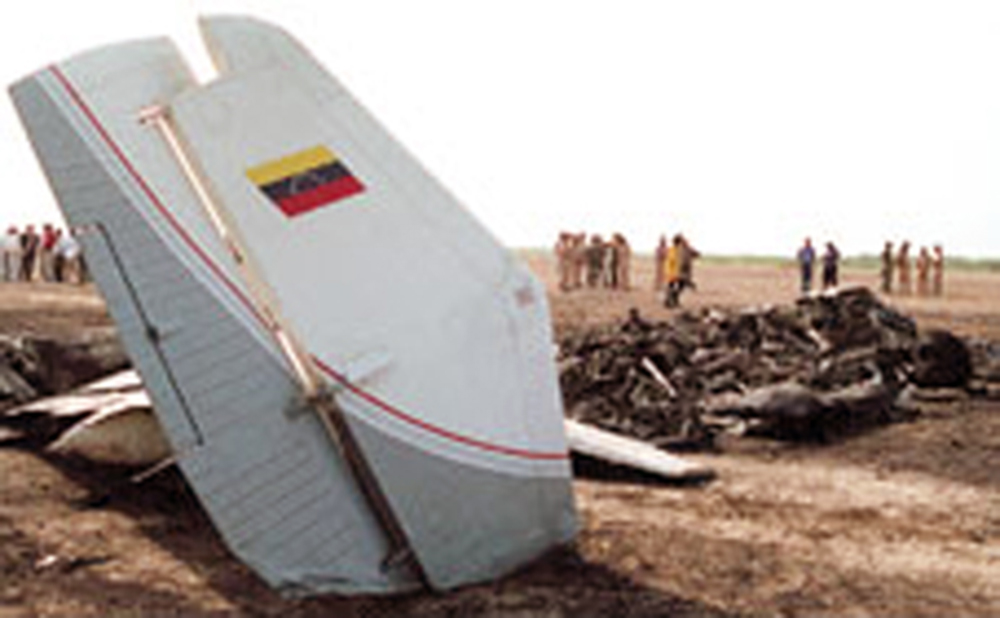
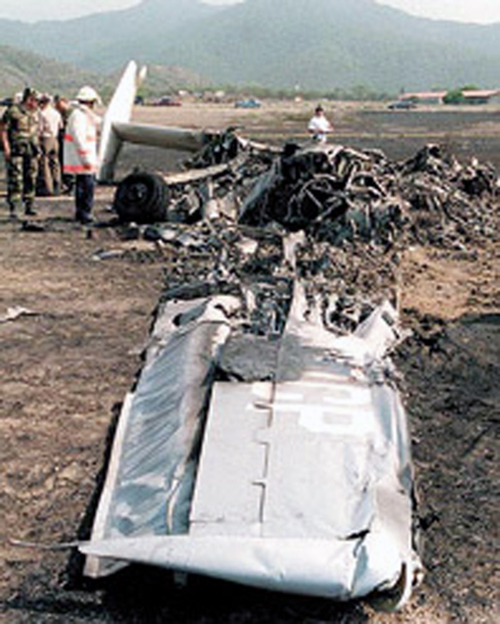
Crash of a Cessna 208B Grand Caravan in Viacha
Date & Time:
Jul 10, 2001 at 1646 LT
Registration:
CP-2395
Survivors:
Yes
Schedule:
La Paz - Rurrenabaque
MSN:
208B-0842
YOM:
2000
Crew on board:
2
Crew fatalities:
Pax on board:
11
Pax fatalities:
Other fatalities:
Total fatalities:
0
Captain / Total hours on type:
304.00
Copilot / Total hours on type:
18
Circumstances:
The single engine aircraft departed La Paz-El Alto Airport at 1637LT on a regular schedule flight to Rurrenabaque, carrying 11 passengers and two pilots. About six minutes later, while cruising at an altitude of 14,500 feet, the engine failed. The crew reduced his altitude and attempted an emergency landing when the aircraft crash landed in a field and came to rest upside down. Both pilots and two passengers were seriously injured while nine other occupants were slightly injured. The aircraft was destroyed.
Probable cause:
The probable cause of the accident was the failure of the engine due to the fracture and separation of all turbine compressor blades due to factors undetermined.
Final Report:
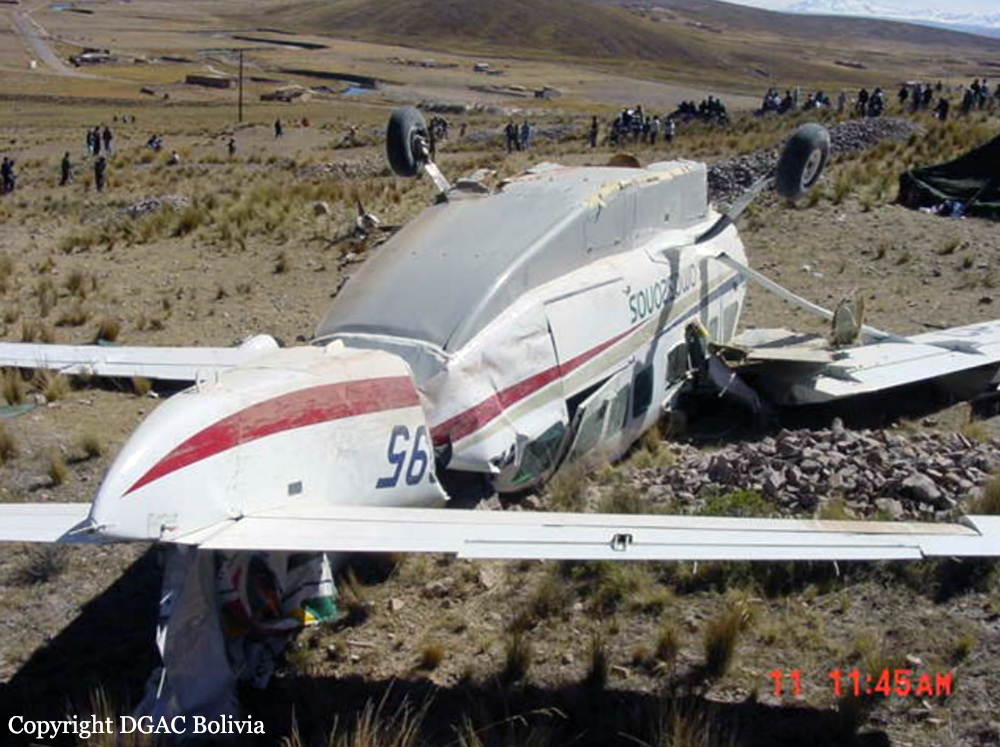
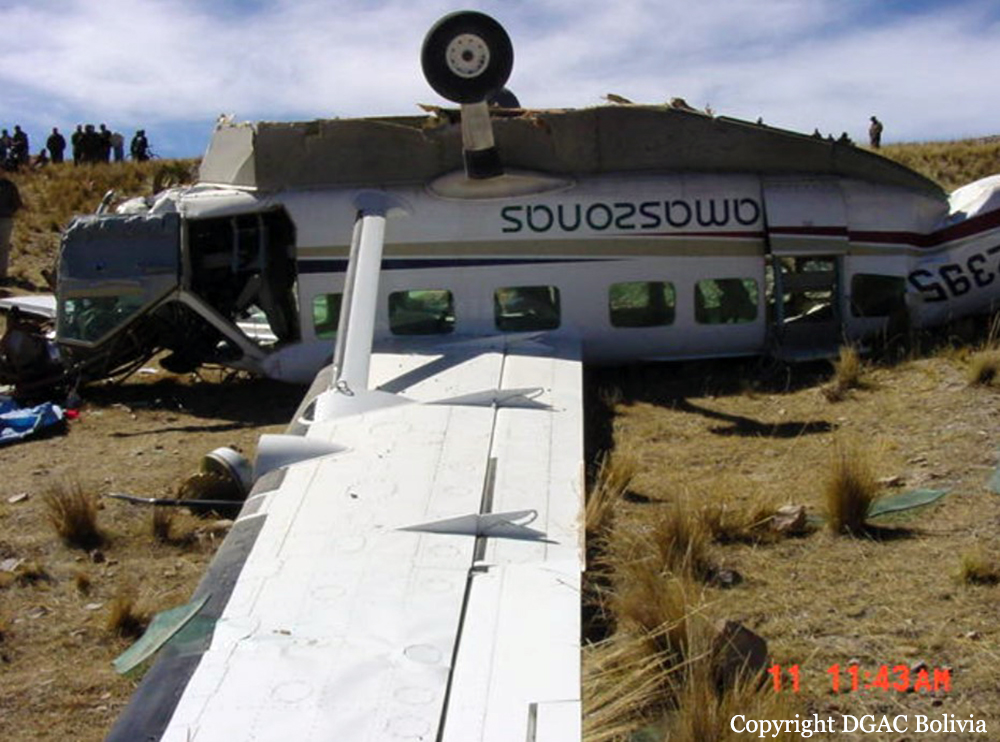
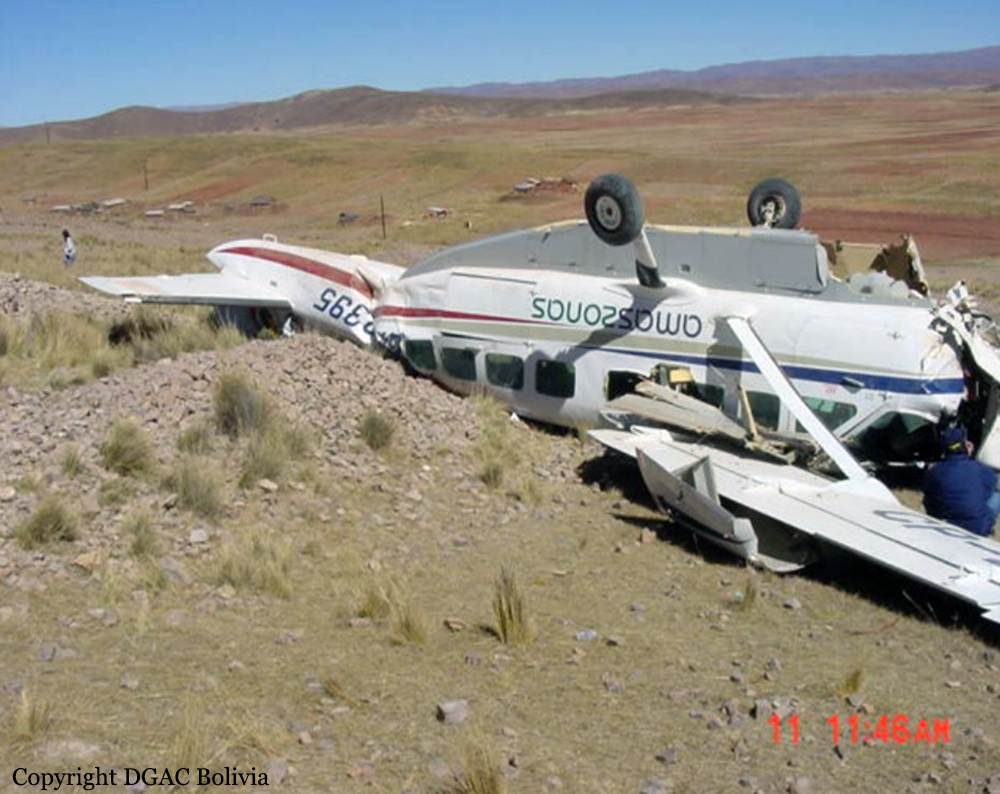

Crash of an Embraer EMB-820C Navajo in Curitiba
Date & Time:
Jun 6, 2001 at 2010 LT
Registration:
PT-EFU
Survivors:
Yes
Schedule:
Guarapuava – Curitiba
MSN:
820-031
YOM:
1976
Crew on board:
2
Crew fatalities:
Pax on board:
1
Pax fatalities:
Other fatalities:
Total fatalities:
0
Captain / Total hours on type:
592.00
Circumstances:
Following an uneventful cargo flight from Guarapuava, the crew started the descent to Curitiba-Bacacheri Airport by night and adverse weather conditions. After touchdown on a wet runway surface, the twin engine aircraft went out of control, overran and collided with a concrete wall. All three occupants were injured, one of the pilot seriously.
Probable cause:
The decision of the crew to land at Curitiba-Bacacheri Airport was not appropriate due to poor weather conditions. The crew underestimated the weather conditions at destination and should take the decision to divert to a more suitable terrain.
Final Report:
Crash of a Embraer EMB-820C Navajo in São Paulo: 1 killed
Date & Time:
Jun 5, 2001 at 2030 LT
Registration:
PT-EHL
Survivors:
No
Schedule:
Franca – São Paulo
MSN:
820-048
YOM:
1977
Crew on board:
1
Crew fatalities:
Pax on board:
0
Pax fatalities:
Other fatalities:
Total fatalities:
1
Captain / Total hours on type:
600.00
Aircraft flight hours:
5289
Circumstances:
The aircraft departed Franca Airport in the evening on a cargo flight to São Paulo, carrying one pilot and bank notes. On a night approach to São Paulo-Congonhas Airport, the pilot cancelled the IFR flight plan when he encountered technical problems with the right engine. He shut down the engine and continued the approach to runway 35R without informing ATC of his situation. Too high on the glide, he apparently decided to initiate a go-around when he lost control of the aircraft that rolled to the left, lost height and crashed in a residential area, bursting into flames. The aircraft was destroyed and the pilot was killed. Two people on the ground were injured.
Probable cause:
It was determined that the hydraulic pump on the right engine failed in flight, forcing the pilot to shut the engine down. It was reported that the pilot continued the approach in a single-engine configuration without informing ATC and that the aircraft was too high on the glide and approaching with an excessive speed. The pilot improperly analyzed the aircraft's flight conditions after shutting down the right engine, causing the aircraft to enter an approach configuration that was not compliant with the published procedures.
Final Report:





